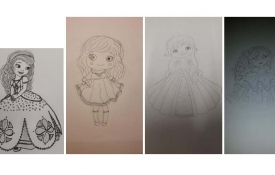-
- Writing the Story
- by Administrator
- 03-05-2019
0.00 of 0 votesChoosing the main character When writing for children, as well as for adults, you need to choose your character. Who, or what, is the main character? Is it a girl? Is she young, old, or somewhere in the middle. Or, perhaps the main character is a boy. Sometimes the main character is a teapot, like in Joan Daulby's "Tessy the Teapot that Couldn't Drip". Bring your character to life Whether writing a novel or a children's picture book, you need to bring your characters to life. In a novel, you do this through descriptive text. For a picture book it is easier. As they say, a picture is worth a thousand words. If you choose to write a picture book, you do not need to rely on the words as much as in a novel to describe the scene. Your illustrator will help to bring your character alive. When writing novels, you need to be descriptive. Show don't tell Which would you rather read? The girl was nervous. Or, The young girl's hands trembled as she smoothed her blue skirt; she picked at a small bit of fluff on one of the white flowers, all the time watching him from behind lowered lids. Put yourself in your readers shoes when describing a scene. Give your character a personality Look around at the people who surround you. They are all different, even when they are the same. Your characters should be like that as well. Give them their own personalities. Maybe the main character has a crooked smile, or a cow lick in their hair. Mention it once in a while in the story. Remind your readers of who the character is. For example: Matt pushed his hair back out of his eyes, swatting at the cowlick he hated when it popped back up. Maria's blood red lips curved into a crooked smile as she watched him cross the crowded room. "How 'ya all doin'?" Mark asked, his voice warm and comforting to all within hearing. The ship was crowded beyond a safe capacity, but the alternative sucked. Mark started writing names in an old tattered notebook. Samantha handed out worn, warm blankets, squeezing a hand in encouragement where needed, all the while thanking God they had managed to save so many; mourning those they lost. The paragraphs above manage to describe the scene while at the same time they show you a bit about the characters. You do not need to describe everything the first time you meet the character. Just like your story, the characters will continue to grow.
-
- Publishing Services
- by Administrator
- 30-04-2019
0.00 of 0 votesWe all have a story inside of us. Most of us keep that story there, hidden deep within. Some of us like to tell the stories while sitting around a campfire or perhaps the kitchen table. And then there are those of us who need to write their story down. What do you do with that story once it has been written down? Do you shove it in the back of a drawer never to be seen again? Or, do you want everyone to read it? If you are the first person, the answer is simple. Stick it in that drawer and forget about it. If you are the second person it becomes a little more difficult. First, you write the story. You read the story over and over and make changes where needed. Then you find someone else to read your story. But is that enough? Or do you want more people to read it? Before you get your story in print for the world to see, you need to make sure it is readable. That is where we come in. Pine Lake Books offers several publishing services starting with editing. Once the story is edited and the best it can be, then we will format it, assign an ISBN, get it into print, and list it on our website book store, as well as with our distributors. Before any of that can be done, you need to submit your story. Type your story double spaced, using Times New Roman, 12 pt. Do not use double spaces, or tabs in your story. Save the story as a .doc .docx or .rtf file. Put your name, email address, phone number, address, and the Title of the Story on the first page, along with the genre. Email the file to pinelakebooks@gmail.com with the words "submission" in the subject line. We will read through the story and let you know what it will take to get it into print.

